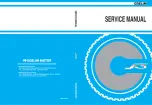
Gearing
130
Adjustments for Competition
You can “adjust” the power delivery of the
standard engine to suit track conditions by
changing gearing. This allows you to utilize a
different portion of the engine’s power range at a
given throttle setting. New gearing may provide
the change you are looking for without the need
to consider further modifications.
The portion of your engine’s power range you
use can be adjusted by changing the final drive
ratio with different sized rear sprockets. Gearing
changes allow you to more closely match the
type of terrain and the available traction.
Normally, a change of one tooth on the rear
sprocket will be sufficient.
There is a choice of both higher and lower final
drive ratios with two optional aluminum driven
sprockets. Like the optional springs, these
sprockets are listed in the Optional Parts List
section of this manual (page 148).
Unless you have the required mechanical
knowhow, tools, and Honda Service Manual,
sprocket changing should be done by your Honda
dealer.
Higher Gearing (less driven sprocket teeth)
• increases top speed in each gear (provided the
engine will pull the higher gearing)
• reduces frequency of shifting (wider gear
ratios)
• reduces engine rpm at a given throttle setting
or ground speed (which may allow better rear
wheel traction on slippery or loose terrain)
However:
• the engine may not pull the higher gearing
• the spacing between gears may be too wide
• engine rpm may be too low
Lower Gearing (more driven sprocket teeth)
• decrease top speed in each gear
• increases frequency of shifting (narrower gear
ratios)
• increases engine rpm at a given throttle
setting or ground speed (which may provide
more power-to-the-ground on good traction
surfaces)
However:
• spacing between gears may be too narrow
• engine rpm may be too high
Some tracks may be watered heavily prior to the
first race, then lightly or not at all during the day.
This results in a track surface that is slippery
during the first few races, then changes from
good to great and back to good and possibly ends
the day with a slick rock-hard consistency.
Ideally, your gearing should be adjusted to suit
all these conditions.
• Wet and slippery or sandy conditions: use a
higher gear (less teeth) to keep engine rpm
down, and avoid unwanted wheelspin. The
engine may bog in certain corners so you’ll
need to slip the clutch to compensate;
downshifting may be too drastic a change in
speed.
• Average conditions: use the standard sprocket.
• Hard (but not slippery) track conditions: use
lower gearing (more teeth) to keep the engine
rpm high where the engine produces the most
power. This may require an extra upshift on
certain sections or perhaps you can just rev it
out a bit longer.
For tight tracks, consider lower gearing to avoid
having to slip the clutch frequently. Repeated
fanning or pulling of the clutch lever in a turn to
raise engine rpm may eventually damage the
clutch system.
A gearing change may help for riding in sand,
where you want to keep the front end light so it
can float from the peak of one sand whoop to the
next. Generally, with higher gearing, it is easier
to maintain that perfect attitude (maximum rear
wheel traction and a light front end) because you
remain in the powerband longer in each gear.
The higher gearing allows you to steer more
efficiently with throttle control and body English.
If you are riding a track with sections where you
choose to over-rev the engine temporarily rather
than shifting up, higher gearing might help.
Sometimes you have to sacrifice performance on
one section of the track to gain a better overall
time. Your goal is the fastest overall lap time,
even if the cost is some sections where the
gearing feels wrong.
If you decide to try a gearing change, have
someone check your times with a stopwatch
(before and after the change) to get an accurate
appraisal of the gearing change. “Seat-of-the-
pants” feelings can’t be trusted. Eliminating
wheelspin with a gearing change can make you
feel like you’re going slower when, in reality,
you’ve decreased your time by increasing your
speed with better traction.
These gearing recommendations should be
evaluated by considering your ability, your riding
style, and the track.
118-133.qxd 06.6.15 14:47 ページ130
Содержание 2007 CRF250R
Страница 1: ......
Страница 3: ...2007 Honda CRF250R OWNER S MANUAL COMPETITION HANDBOOK Contents qxd 06 6 15 14 27 1...
Страница 15: ...10 Before Riding 001 023 qxd 06 6 15 14 28 10...
Страница 21: ...16 Basic Operating Instructions 001 023 qxd 06 6 15 14 28 16...
Страница 143: ...138 Tips 134 160 qxd 06 6 15 14 49 138...
Страница 155: ...150 Technical Information Wiring Diagram THROTTLE POSITION SENSOR SPARK PLUG 134 160 qxd 06 6 15 14 49 150...
















































